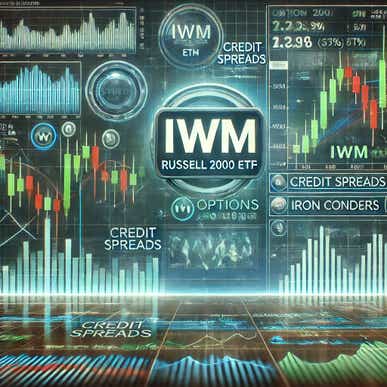Why IWM Is My Go-To ETF for Selling Defined Risk Options

Why IWM Is My Go-To ETF for Selling Defined Risk Options
High IV, diversification and mean reversion make IWM ideal for options premium sellers. Here’s how to trade Russell 2000 ETF with defined risk strategies.
My approach to trading options revolves around selling premium with defined risk strategies. And one of my favorite underlying assets to trade is the iShares Russell 2000 ETF, the exchange-traded fund (ETF) that’s known as IWM and tracks the Russell 2000. The combination of high implied volatility, diversification and a tendency to mean revert makes IWM ideal for strategies like credit spreads, iron condors and other defined-risk setups.
In this post, I’ll break down why IWM is my go-to choice, describe the mechanics behind selling defined risk options and share how I manage risk effectively while maximizing profitability.
Why IWM?
There are thousands of tradeable symbols in the options market, so why is IWM one of my main options for 2025? Here are some reasons:
Rich options premiums because of higher implied volatility
Implied volatility plays a crucial role in options pricing. The higher the IV, the more expensive the option premiums, which means better pricing for premium sellers.
IWM, as a small-cap ETF, historically carries higher IV compared to large-cap ETFs like SPY (S&P 500) or QQQ (Nasdaq 100). This is because small-cap stocks are generally more volatile than large-cap stocks because of their sensitivity to economic conditions, interest rates and investor sentiment.
For an options seller like me, higher IV means I can collect more premium, enabling me to:
- Open positions farther from the current price while still receiving a decent credit.
- Take advantage of mean-reverting volatility.
- Improve my probability of profit.
This makes selling credit spreads, iron condors and put spreads on IWM much more attractive than trading lower-IV assets.
Diversification reduces single-stock risk
One of the biggest concerns when trading individual stocks is earnings announcements, surprise news or company-specific events that can create large, unpredictable moves. As an ETF that holds 2,000 small-cap stocks, IWM helps mitigate that risk.
Because IWM tracks the broader small-cap market, it’s less susceptible to wild, single-stock volatility than something like Tesla (TSLA) or Nvidia (NVDA), where one earnings report or news event can send the stock surging or crashing.
This diversification makes selling defined-risk strategies on IWM more predictable and manageable because I’m trading an index instead of an individual stock with company-specific risk.
That said, it’s important to recognize some of the challenges small-cap stocks face. According to Yahoo Finance, "The economist underlines the biggest problem components of the Russell 2000 small-cap index (^RUT): 40% of them have no earnings." Naomi Buchanan puts it this way: “If rates are higher for longer, that means small-cap companies will continue to struggle with earnings and therefore not be able to service their debt servicing costs."
While this creates headwinds for IWM, it also contributes to higher implied volatility, making it even more attractive for options sellers who thrive on rich premiums.
Defined risk strategies: My approach to selling IWM options
Selling options can be a high-probability strategy, but it comes with risks. That’s why I prefer to use defined-risk strategies—these allow me to collect premium while limiting potential losses. Here are my go-to trades on IWM:
Credit spreads (put and call spreads)
A credit spread involves selling one option and buying another option farther out of the money to limit risk while still collecting premium.
- Bull put spread: If IWM drops sharply and IV rises, I sell a put credit spread below the current price, betting on mean reversion.
- Bear call spread: If IWM spikes and IV is elevated, I sell a call credit spread above the price, expecting a pullback or consolidation.
By keeping risk defined, I know my maximum loss upfront while still taking advantage of IWM’s high IV.
Iron condors
An iron condor combines a put credit spread and a call credit spread, enabling me to profit from IWM staying in a range. Because IWM tends to mean revert, I often sell iron condors during high IV periods, collecting a nice credit while keeping risk capped.
- If IV is high, I set wider wings to capture more movement.
- If IV is low, I go with tighter wings to maximize the credit collected.
Iron condors on IWM work particularly well because of how the ETF trades in ranges over time.
Managing risk while selling premium on IWM
Risk management is key when selling options, even when using defined risk trades. Here’s how I manage my IWM trades effectively:
- Trade with a high probability of profit – I typically sell options with a delta between 20-30, meaning I have a 70-80% probability of success.
- Adjust positions when needed – If IWM moves against my trade, I may roll the position out in time or adjust the strike prices to stay in the game.
- Exit early when profitable – I often close trades at 50-60% of max profit to avoid unnecessary risk.
Final thoughts: Why IWM is my favorite ETF for selling premium
Selling defined risk options on IWM has been attractive because of its high IV, mean-reverting tendencies, and built-in diversification. Focusing on credit spreads and iron condors, I can collect premium without taking unlimited risk while improving my probability of success.
For traders looking to sell options in a more controlled way, IWM provides a great balance of volatility, liquidity and range-bound movement. If you’re considering selling premium, IWM is one of the best ETFs to trade.
Errol Coleman appears on the tastylive network shows Today’s Assignment and Trades on the Go.
Options involve risk and are not suitable for all investors. Please read Characteristics and Risks of Standardized Options before deciding to invest in options.